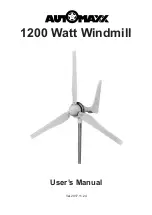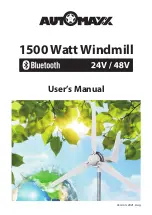
AIR 40, AIR Breeze, AIR 30, AIR X MARINE and AIR SILENT-X are trademarks of Primus Wind Power 2013 Primus Wind Power Inc.
AIR Owner’s Manual
3-CMLT-2020-A
23
AIR WIRE SIZING
All electrical systems lose energy due to resistance in the wires.
•
Large wires have less resistance but are more costly.
•
Resistance losses increase with increasing current. High wind sites will bene-
fit from using a larger size wire to take advantage of the greater power pro-
duction potential.
•
Conversely, in low wind sites it may not be cost effective to increase the
wire size.
The following wiring sizes provide maximum annual energy losses of 4% or less
for sites with a 12 mph average wind speed (assuming the standard Rayleigh
distribution of wind speeds) which is sufficient for most sites.
To determine the size wire, measure the distance from the batteries to your AIR
wind turbine; including tower height. Reference the chart matching your system
voltage and number of turbines and select the wire size.
We recommend these as the minimum wire sizes; for optimal perfor-
mance use the largest wires that are practical and affordable. Wire con-
nections (e.g. splices, etc.) also contribute additional resistance in the
overall wire run. Care should be taken to insure all connections are se-
cure.
It is recommended that turbines installed in corrosive environments (e.g.
marine/saltwater) should use tinned copper wiring. It is also recommend-
ed to use “stranded” wire for all AIR installations (“green” ground wire
can be solid wire as needed).
NOTE: Local, state, and national electrical codes have precedence over
these recommendations and must be followed to ensure the safety of
your system.
Note: Wiring Resistance and Regulation
Depending on your exact system configuration including other charging
sources in your system, wiring resistance may affect the regulation set
point of the turbine. Higher wiring resistance (smaller wires) will tend to
lower the voltage at which the turbine enters regulation and stops charg-
ing. The recommended wiring sizes should provide little effect on the reg-
ulation set point, but all installations should be observed over time to
ensure that the batteries are charged to the proper voltage.
IMPORTANT: Install overcurrent protection accordance with CEC
and NEC.
TIP:
Smaller wires will lower the voltage at which the AIR wind
turbine enters regulation and stops charging.

































